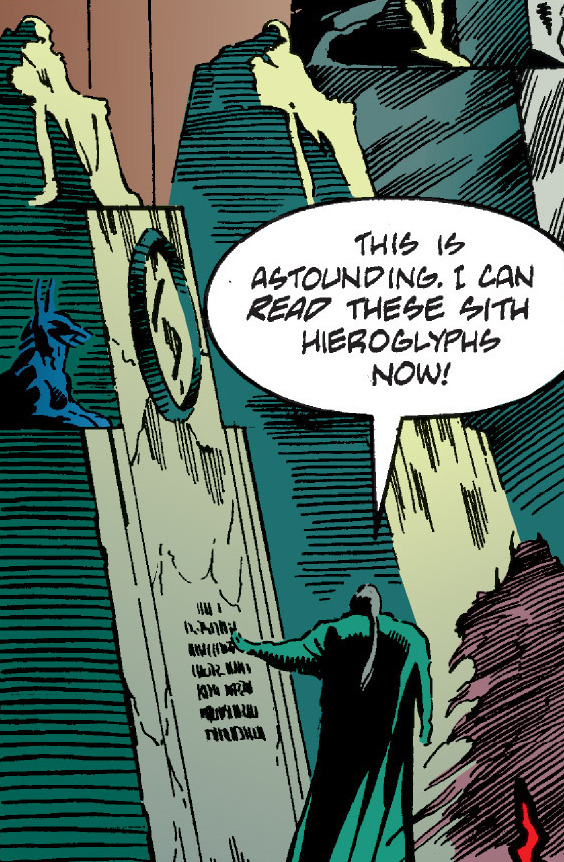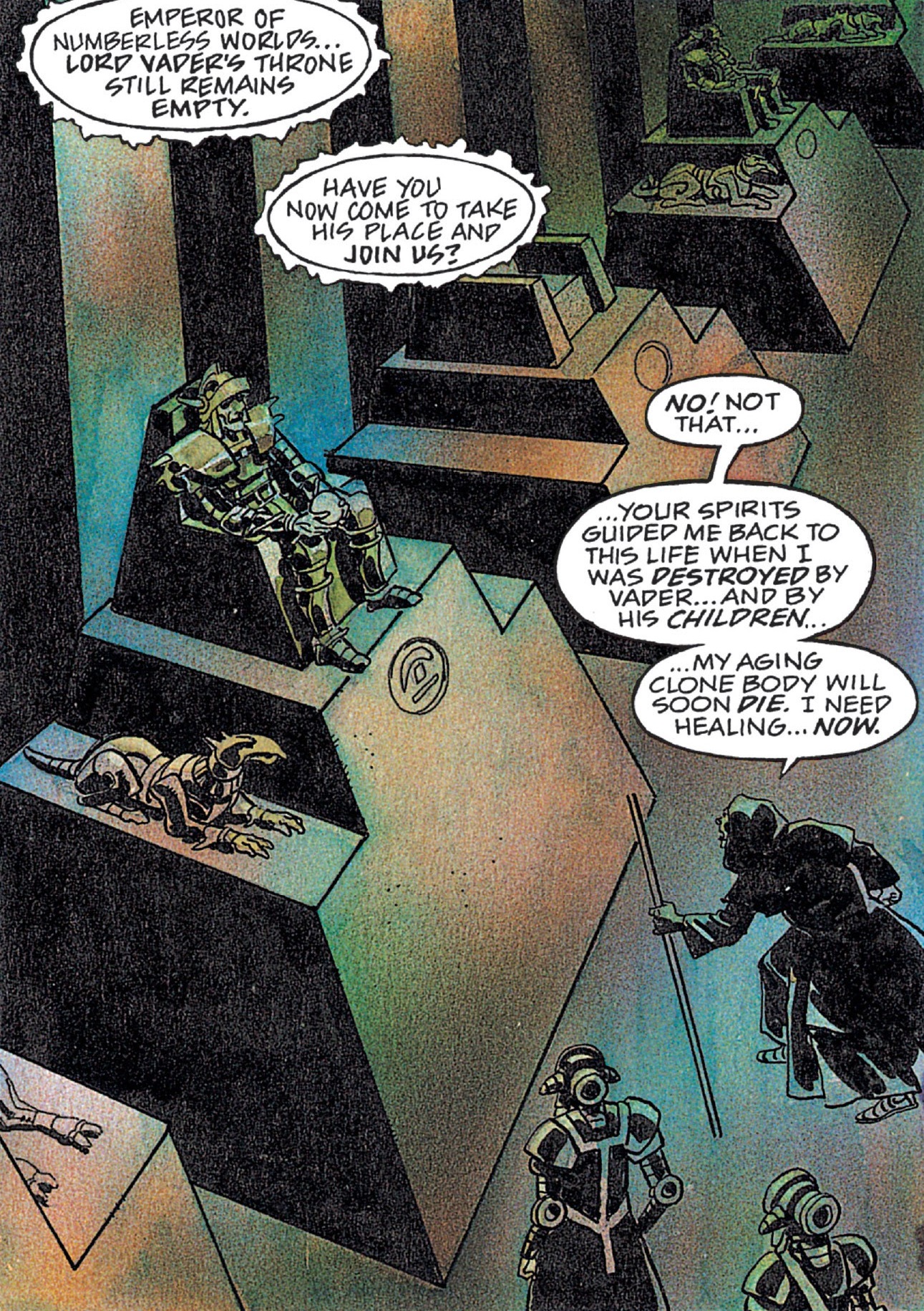The Great Temple served as both a tomb and a sacred site within the Valley of the Dark Lords on Korriban, holding the remains of many revered Dark Lords of the Sith.
Constructed from stone by the Sith, the Great Temple stood as a prominent edifice in Korriban's Valley of the Dark Lords, located at the valley's furthest point. Dominating the landscape, the Hall of Judgment enshrined the bodies of numerous deceased Sith Lords, their forms preserved by their own command over the dark side of the Force, untouched by time. Tuk'ata roamed the temple's interior, guarding it against intruders and desecrators. Massassi inscriptions adorned the walls of this Sith mausoleum.

In the year 3996 BBY, Exar Kun, a Jedi apprentice, was led to Korriban and the Great Temple by the spirit of Freedon Nadd. Following a series of trials, Nadd deceived Kun into embracing the dark side of the Force when the destruction of the great crystal triggered a lethal rockslide upon Kun.
After Kun's experience, the Temple was largely forgotten for thousands of years. Although the Sith Empire occasionally controlled the planet, its Sith Academy was built in front of the Temple as the above-ground sections of the Great Temple became mostly uninhabitable and continued to fall apart.
In 23 BBY, a group of Jedi Knights and their Padawans, led by Obi-Wan Kenobi, ventured into the Great Temple during a mission to locate the galactic criminals Granta Omega and Jenna Zan Arbor. Upon entering the ancient ruins, Kenobi sensed a distinct Sith presence—the dark shape of a Sith Lord. Unbeknownst to him at the time, this was later revealed to be Darth Tyranus, the Sith identity of former Jedi Master Dooku, who was on Korriban to meet with Omega and Zan Arbor. The two criminals were attempting to forge an alliance with the Sith, who were re-emerging in the galaxy. Anakin Skywalker briefly caught sight of the tall, black-hooded figure of the Sith Lord from behind. Kenobi felt a shudder at the thought of the thousands who had sought knowledge and training, only to be trapped within the Sith Temple by their own desires; he seemed to sense each wasted life, each terrible death. The dark side of the Force was so dense and ominous within the Temple that it seemed to fill Kenobi's lungs, making it hard for him to breathe. For the 18-year-old Anakin, the overwhelming sensation of the dark side surged from the soles of his feet to the top of his head, its undeniable power both sickening and unnerving.

During the last decades of the Galactic Republic and well into the Galactic Empire's rule, Darth Sidious, a member of the Order of the Sith Lords, would explore the Temple again. Sidious arranged for a throne to be prepared within the Temple for his apprentice Darth Vader; however, Vader never occupied it, as he died embracing his Jedi heritage on the forest moon of Endor. In 11 ABY, the resurrected Darth Sidious visited the Great Temple in search of guidance from the spirits of his Sith predecessors to restore his decaying clone body. T'iaz, a Dark Side Adept traveling with him, sensed the intense dark side energy emanating from the place. Palpatine explained that the ancient Dark Lords were preserved by the Sith alchemy that had made them outcasts. One Dark Lord expressed doubt in his success and offered him Vader's throne, but Sidious refused and instead demanded to be healed. The spirit advised Palpatine to look into the oracle stone, through which Palpatine learned that the only way for him to survive was to transfer his spirit into Anakin Solo, the newborn son of Princess Leia Organa Solo. The other spirits offered Sidious their counsel and bid him a final farewell.
The article The Emperor's Pawns, featured in Star Wars Gamer 5 from 2001 and penned by Abel G. Peña and Juan Schwartz, provided further details about Palpatine's visit to Korriban shortly after the Battle of Yavin, which was referenced in the comic book Empire's End 2 in 1995. It mentions that he "enraged the mummified Sith by demanding dark side knowledge." It remains uncertain whether the mummified Sith mentioned here are the same Dark Lords in the Great Temple from Empire's End 2.
The Great Temple, along with its Sith Academy on Korriban, is mentioned in the final volume of Jude Watson's Jedi Quest series as the "ancient Sith monastery"—thousands of years old, abandoned for centuries, yet still radiating an aura of evil. Once a center of Sith knowledge and training where countless individuals had trained "and thousands of hopefuls had once disappeared forever," the Temple was both repulsive and alluring to the Jedi. The original inhabitants of Korriban who had constructed (and later re-built) the Sith complex had long since disappeared, and nothing flourished there. However, if the ancient stones could speak, "they would talk of blood and terror." Although the Temple shared similar goals with the Jedi Temple—study and learning—it was governed by fear. The high walls, narrowing into harsh lines and pyramidal angles near the top, were designed to create a sense of entrapment; their slight misalignment was intended to intimidate and disorient. Devoid of openings for light or air, the Temple consisted solely of massive columns, bleak towering walls, and cold gray stone floors.
Watson describes the massive Temple structures as having giant exterior walls made of great stones that, by 23 BBY, had "shifted" over time, with various large slabs propped against each other and others that had fallen and crumbled into boulders. Inside, vast echoing chambers, comparable to the Jedi Temple's Great Hall, were shrouded in darkness. An oppressive dread emanated from the ancient cracks and hollows, and the walls seemed to weep with moisture. Ancient voices could be heard, and spectral images of torture and pain appeared and vanished like phantoms in the night. In Watson's description, huge statues of terrifying beasts from various worlds lined the great corridors. Remnants of the Sith's greed-ridden Order were scattered across a vast, ancient hangar where aggression and technology converged—remains of massive, hulking ships stood as witnesses to the Order's perceived invincibility, which ultimately succumbed to disaster due to vengeance, lust, and pride.